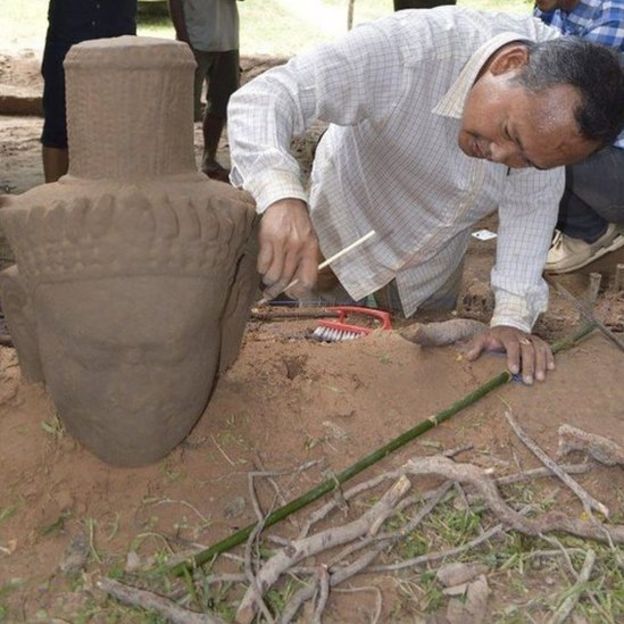Cambodia: After too many centuries passed away and many cities have started and collapsed but to then also if any object found safely inside earth would be surprised. A team of archaeologists were happy, as they find pottery shards when they excavate a site in Angkor Archaeological Park in Cambodia.
On last Saturday site on Angkor Archaeologists park seemed like something that happens only in the movies. On last Saturday as the team was on excavation in Siem Reap province, a team of archaeologists found a 1.9 meter statue weighing about 200 kg at an 800-year-old site in Angkor Park.
The archaeology team holds a religious ceremony on Sunday to ask the spirit protecting the site permission to move the statue they unearthed the previous day to the Preah Sihanouk Museum in Siem Reap province.
An archaeologist with Apsara Authority said “We were very surprised to find this. The sandstone statue is missing its feet and parts of its legs. Had it been whole, it would have stood at least 2.1 meters, he said. In the image of a guard, it would have stood on the grounds of a hospital that was located next to the northern entrance of Angkor Thom, the walled city of King Jayavarman VII.
The excavation began last Friday and is meant to last about 12 days. The hospital is one of the 102 that the 12th century king is believed to have built throughout his Angkorian empire, said Tan Boun Suy, deputy director-general for the Apsara Authority.
“Jayavarman VII’s reign was truly remarkable in terms of social programs,” he said. “The hospital consisted of wooden buildings and a chapel erected in stones. What is left is the chapel, as wooden structures have long disappeared.”
Archaeologists further added, If the excavation unearths other objects of the time, it would provide useful information on the life and activities in those hospitals and also the lives of ordinary people of the era, of which very little is known.
For this excavation, the Apsara Authority retained Rethy Chhem as an adviser. A university professor and radiologist who heads the Cambodia Development Resource Institute, a Phnom Penh think tank, Dr. Chhem is also a historian and the authority on Angkorian-era hospitals and medicine, Mr. Boun Suy said.
Archaeologists made a grid to draw the statue yesterday before moving it. Moreover, Dr. Chhem initiated and led the 2006 excavation of a hospital built during the same era near the western gate of Angkor Thom alongside French archaeologist Christophe Pottier.
“There are four hospitals identified at the four cardinal points of Angkor Thom,” Dr. Chhem said last Friday. “They were identified by French archaeologists about 100 years ago, but had never been excavated.”
Many statues of the Buddha were destroyed during the reign of Jayavarman VIII in the mid-13th century in his effort to restore Brahmanism in the country, and most of those that remained were looted, although some were buried for their protection.
Dr. Chhem and the excavation team never dreamed of finding one of the hospital’s major statues on the second day of excavation. And yesterday, the team kept making discoveries: They found a piece of another statue, Mr. Sokrithy said. “We also found much evidence of wooden structures such as roof tiles and ceramics.”
The excavation is conducted by the Apsara Authority in cooperation with the Institute of Southeast Asian Studies’ Yusof Ishak Institute in Singapore. As part of a training program, 10 students from Asian countries, the U.S. and Australia are taking part in the excavation, Mr. Sokrithy said.





